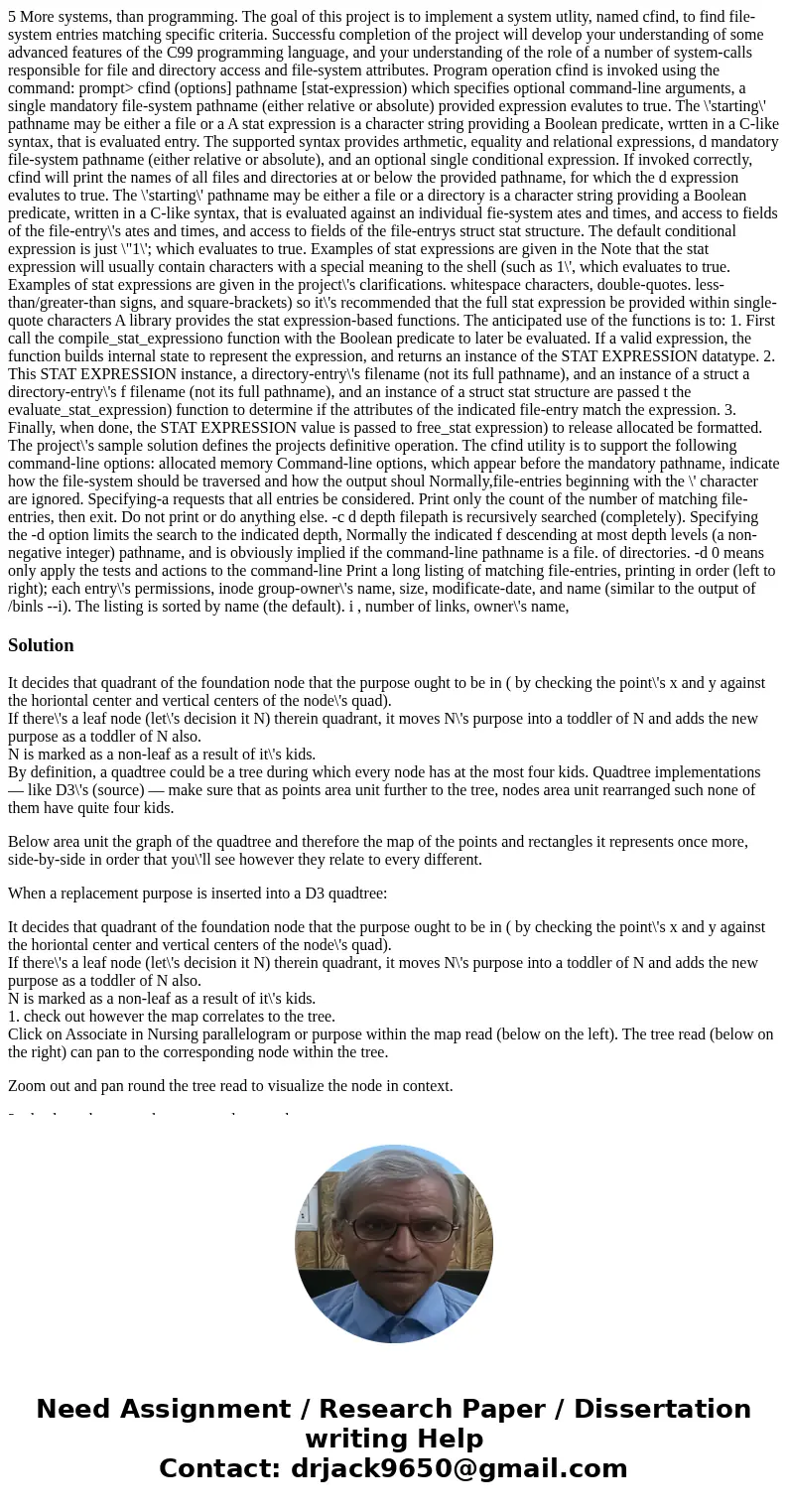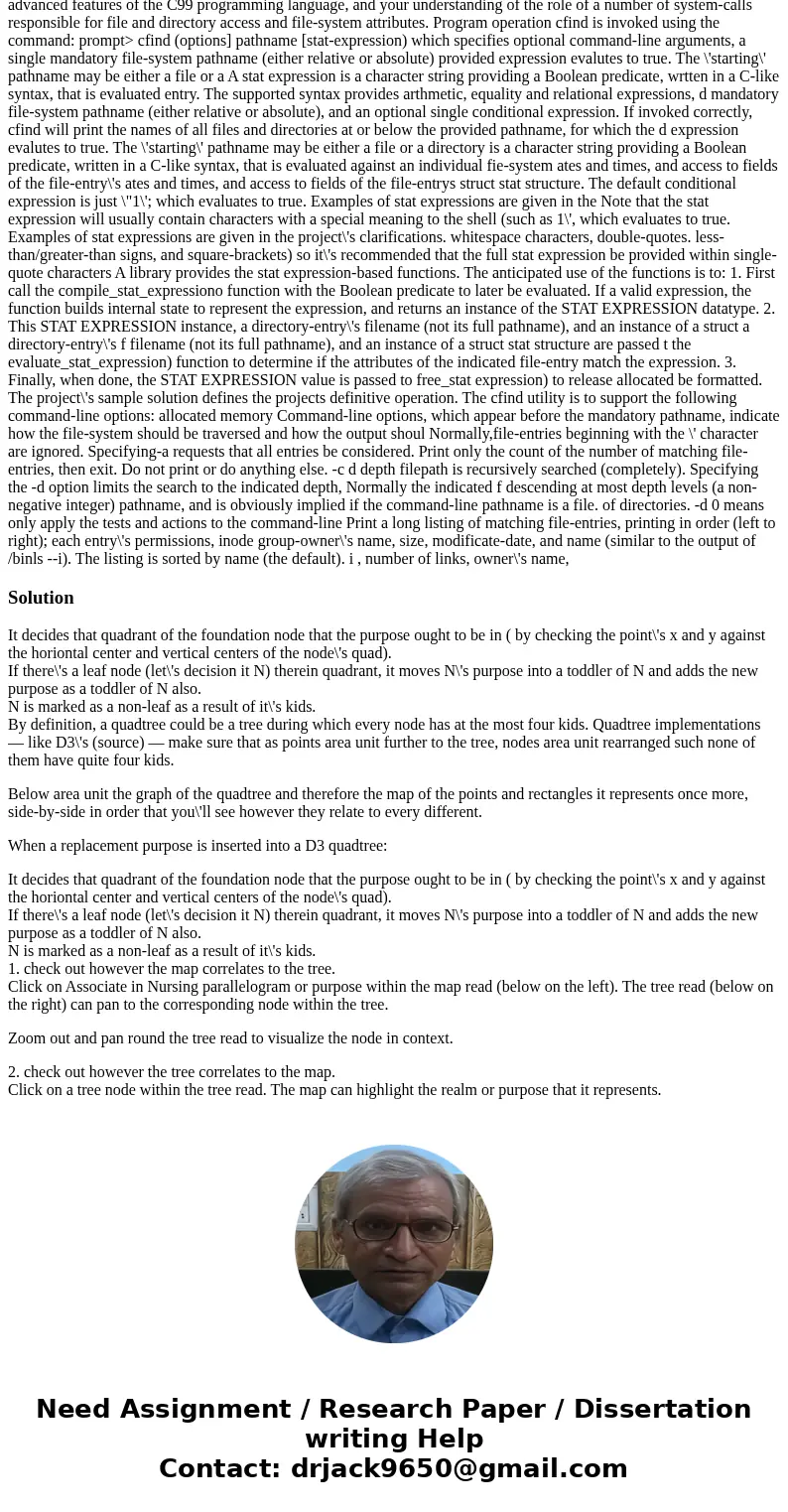5 More systems, than programming. The goal of this project is to implement a system utlity, named cfind, to find file-system entries matching specific criteria. Successfu completion of the project will develop your understanding of some advanced features of the C99 programming language, and your understanding of the role of a number of system-calls responsible for file and directory access and file-system attributes. Program operation cfind is invoked using the command: prompt> cfind (options] pathname [stat-expression) which specifies optional command-line arguments, a single mandatory file-system pathname (either relative or absolute) provided expression evalutes to true. The \'starting\' pathname may be either a file or a A stat expression is a character string providing a Boolean predicate, wrtten in a C-like syntax, that is evaluated entry. The supported syntax provides arthmetic, equality and relational expressions, d mandatory file-system pathname (either relative or absolute), and an optional single conditional expression. If invoked correctly, cfind will print the names of all files and directories at or below the provided pathname, for which the d expression evalutes to true. The \'starting\' pathname may be either a file or a directory is a character string providing a Boolean predicate, written in a C-like syntax, that is evaluated against an individual fie-system ates and times, and access to fields of the file-entry\'s ates and times, and access to fields of the file-entrys struct stat structure. The default conditional expression is just \"1\'; which evaluates to true. Examples of stat expressions are given in the Note that the stat expression will usually contain characters with a special meaning to the shell (such as 1\', which evaluates to true. Examples of stat expressions are given in the project\'s clarifications. whitespace characters, double-quotes. less-than/greater-than signs, and square-brackets) so it\'s recommended that the full stat expression be provided within single-quote characters A library provides the stat expression-based functions. The anticipated use of the functions is to: 1. First call the compile_stat_expressiono function with the Boolean predicate to later be evaluated. If a valid expression, the function builds internal state to represent the expression, and returns an instance of the STAT EXPRESSION datatype. 2. This STAT EXPRESSION instance, a directory-entry\'s filename (not its full pathname), and an instance of a struct a directory-entry\'s f filename (not its full pathname), and an instance of a struct stat structure are passed t the evaluate_stat_expression) function to determine if the attributes of the indicated file-entry match the expression. 3. Finally, when done, the STAT EXPRESSION value is passed to free_stat expression) to release allocated be formatted. The project\'s sample solution defines the projects definitive operation. The cfind utility is to support the following command-line options: allocated memory Command-line options, which appear before the mandatory pathname, indicate how the file-system should be traversed and how the output shoul Normally,file-entries beginning with the \' character are ignored. Specifying-a requests that all entries be considered. Print only the count of the number of matching file-entries, then exit. Do not print or do anything else. -c d depth filepath is recursively searched (completely). Specifying the -d option limits the search to the indicated depth, Normally the indicated f descending at most depth levels (a non-negative integer) pathname, and is obviously implied if the command-line pathname is a file. of directories. -d 0 means only apply the tests and actions to the command-line Print a long listing of matching file-entries, printing in order (left to right); each entry\'s permissions, inode group-owner\'s name, size, modificate-date, and name (similar to the output of /binls --i). The listing is sorted by name (the default). i , number of links, owner\'s name,
It decides that quadrant of the foundation node that the purpose ought to be in ( by checking the point\'s x and y against the horiontal center and vertical centers of the node\'s quad).
If there\'s a leaf node (let\'s decision it N) therein quadrant, it moves N\'s purpose into a toddler of N and adds the new purpose as a toddler of N also.
N is marked as a non-leaf as a result of it\'s kids.
By definition, a quadtree could be a tree during which every node has at the most four kids. Quadtree implementations — like D3\'s (source) — make sure that as points area unit further to the tree, nodes area unit rearranged such none of them have quite four kids.
Below area unit the graph of the quadtree and therefore the map of the points and rectangles it represents once more, side-by-side in order that you\'ll see however they relate to every different.
When a replacement purpose is inserted into a D3 quadtree:
It decides that quadrant of the foundation node that the purpose ought to be in ( by checking the point\'s x and y against the horiontal center and vertical centers of the node\'s quad).
If there\'s a leaf node (let\'s decision it N) therein quadrant, it moves N\'s purpose into a toddler of N and adds the new purpose as a toddler of N also.
N is marked as a non-leaf as a result of it\'s kids.
1. check out however the map correlates to the tree.
Click on Associate in Nursing parallelogram or purpose within the map read (below on the left). The tree read (below on the right) can pan to the corresponding node within the tree.
Zoom out and pan round the tree read to visualize the node in context.
2. check out however the tree correlates to the map.
Click on a tree node within the tree read. The map can highlight the realm or purpose that it represents.


 Homework Sourse
Homework Sourse